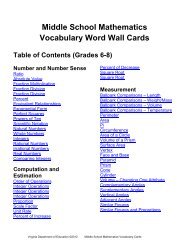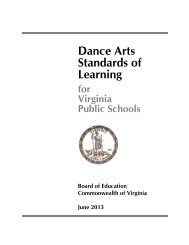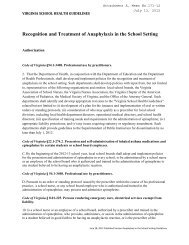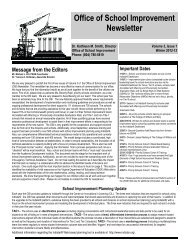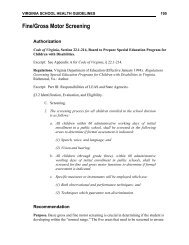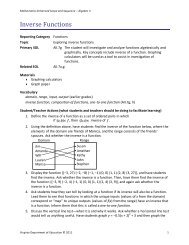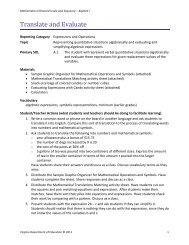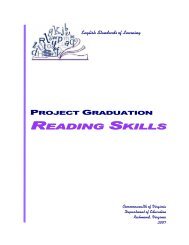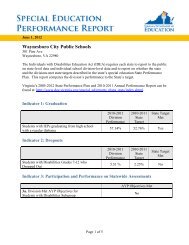, -Spilt rRANkLI.LJ P. Ml~H-I;L~ f ".~ ..o1~",L tl._~ P C)/U.l'~ /2..'1/
, -Spilt rRANkLI.LJ P. Ml~H-I;L~ f ".~ ..o1~",L tl._~ P C)/U.l'~ /2..'1/
, -Spilt rRANkLI.LJ P. Ml~H-I;L~ f ".~ ..o1~",L tl._~ P C)/U.l'~ /2..'1/
Create successful ePaper yourself
Turn your PDF publications into a flip-book with our unique Google optimized e-Paper software.
"f<br />
04-117<br />
CASE CLOSURE SUMMARY REPORT<br />
...Public Schools ~<br />
School Division N~ of Parents<br />
"," January 6. 2005<br />
NarM of child Date of Decision<br />
,<br />
John F- C'-atferky, R~- Gerard S- Ru&el, R~.<br />
Counsel representing LEA Counsel representing Parents/Child<br />
-<strong>Spilt</strong><br />
Party Initating Hearing Prevailing Party<br />
Hearing Officer's Detemlination of Issues:<br />
(1) IEP's proposed by PS did not provide FAPE because they were not<br />
"appropriate" and violate mEA<br />
(2) The Parent's private placement was not reasonably calculated to enable the<br />
child to receive educational benefits.<br />
(3) PS was found to be not in violation of the Sec.504 of the Rehabiliation Act<br />
of 1973 for alleged retaliation.<br />
(4) PS violated procedure in one unjustified instance.<br />
Hearing Officer's Orders and Outcome of Hearing:<br />
PS ordered to provide and appropriate education to include reliable and<br />
intensive one-on-one instruction in the child's academic studies.<br />
PS ordered to provide compensation and compensatory services for certain<br />
related services obtained privately.<br />
This certifies that I have completed this hearing in accordance with regulations and have<br />
advised the parties of their appeal rights in writing. The written decision from this hearing<br />
is attached in which I have also advised the LEA of its responsibility to submit an<br />
implementation plan to the parties, the hearing officer and the SEA within 45 days.<br />
<strong>rRANkLI</strong>.<strong>LJ</strong> P. <strong>Ml~H</strong>-I;<strong>L~</strong> f ".~ ..o1~",L<br />
<strong>tl</strong>._~ P C)/U.<strong>l'~</strong> /<strong>2.</strong>.<strong>'1</strong>/<br />
Printed ~ 0 f Hearing Officer l"'Sl~tm~~L;..-L.1"?"Z I. ./ /~-P ~
.. ,<br />
..<br />
VIRGINIA DEPARTMENT OF EDUCATION<br />
DMSION OF SPECIAL EDUCAnON AND STUDENT SERVICES<br />
-.Public Schools ---<br />
School Division Name of Parents<br />
Dr.. ---<br />
Interim Superintendent Name of Child<br />
lohn FCafferky~ Gerard S. RugeL E&I-<br />
Counsel representing LEA Counsel representing Parents/Child<br />
Franklin P. Michels .<br />
,..6!<br />
Name of Hearing Officer Party Initiating Hearing<br />
POS"nJEARING REPORT AND DECISION<br />
SUMMARY OF CASE<br />
This matter concerns a request for a due process hearing initiated by and<br />
.(parents) on behalf of their so~ ,16 years old, who<br />
has multiple disabilities which qualifies him for services under The Individuals with<br />
Disabilities Act (IDEA), 20 U.S.C. Sec. 1400 et seq. and Federal Regulations, 34 CFR<br />
300. In requesting a due process hearing the Parents assert that the Public<br />
Schools ( PS or School) has failed to provide with a free appropriate public<br />
education (F APE) and that the School has committed a number of procedural violations.<br />
Among these is the charge that the School was in violation of Section 504 of tile<br />
Rehabilitation Act, 34 C.F.R. Sec.104.61 by allegedly retaliating against<br />
in bringing cril11ilwl charges for violating compulsory attendance laws.<br />
At the request of both the parties, continuances have been granted thus extending<br />
the completion of this case beyond 45 days. The original date of July 8, 2004 was<br />
arbitrarily set to comply with tM reguJations pending a ~ing of the parties. At the<br />
confere[k;e the parties justified a continuation as needed for the extensive preparation for a<br />
lengthy hearing. The parents and the parties agreed it was in 's best interest and it<br />
was acknowledged that he would continue with his present instruction. Continuations to<br />
September 20 and to October 25 were justified as being in IS best interest to<br />
permit the parties to schedule and complete various tests and evaluations. It was found<br />
that the continuations were in IS best interest. This case has a long history of<br />
disagreement between the parents and the school including appeals to the Virginia<br />
Department ofEducatio~ a due process hearing and mediation. The parents concerned<br />
about their child with disabilities have availed themselves of all the protections which is<br />
provided for in the law which they have every right to do. To dismiss the proceeding,<br />
however, on the ground that the parties in requesting evaluations were not prepared to go<br />
to hearing would only have resuhed in a new request for hearing likely to present some of<br />
the saIre problems and further delay a resolution of the matter. For a discussion of the
..<br />
., 3<br />
" "~<br />
<strong>2.</strong> A psychological evaluation was conducted on in in 1991<br />
when he was 3 years old and he tested at age equivalents ranging from one year to 2 years,<br />
six months. A speecManguage evaluation conducted in October 1992 at Children's<br />
Hospital of revealed a severe delay in receptive and expressive language skills<br />
and limited oral motor ski&. An occupational therapy evaluation conducted at the same<br />
hospital in September of 1992 revealed delays in gross motor and fine DX>tor skills. At<br />
five years, one month a developmental evaluation at the University of conducted<br />
by Dr. revealed an IQ of 42 and a mental age equivalent to two years, five months.<br />
The SCores from tests indicated that displayed significant delays in cognitive<br />
functioning as well as adaptive behavior and that he met the criteria as having moderate<br />
mental retardation. (School Exh. 9)<br />
3. was tested numerous times since the age of three. Educational and<br />
psychological tests generally ranged from mild to moderate levels of mental retardation<br />
with severe speech and language deficits. went through a triennial evaluation in<br />
April 1996, prior to leaving .and was found eligible for continued special<br />
education services as a student with mild retardation and with additional speech/language<br />
mtp~Kment. (School Exh. 11)<br />
4. When tested by the .Public Schools in a psychological evaluation<br />
in September 1996, was found to demonstrate limited intellectual abilities both<br />
verbally and nonverbally. Nonverbal measures ofintellectuaI abilities revealed functioning<br />
within the mild to moderate range of mental retardation. I it was fo~ ~ed<br />
a highly structured, smaI1 class environment with intense lan~ge intervention. (School<br />
Exh.ll)<br />
5. A private neuropsycholo~ist, consulted by the parents in September 1996, Dr.<br />
~ found that meets the neuropsychological standards for a<br />
Pervasive Developmental Disorder, Not Otherwise Specified including<br />
traits/characteristics of atypical autism. (parents Exh. 19 A, Vol ll)<br />
6. In April 1996 in the Public Schools an independent educational<br />
program (IEP) was prepared for which placed rum as non-categorical with<br />
speech and language instruction in the third grade at Elementary School in<br />
7.<br />
.(parents 2A, Vol I)<br />
was examined and tested by Dr. , MD on October I,<br />
1996 upon referral by Dr. :and he was in agreement with the assignment of<br />
pervasive developmental disorder or atypical autistic disorder.<br />
8. was given augmentative COmmunication evaluation at the Kennedy<br />
Krieger Children's Hospital in September 1998 when he was eleven old. On receptive<br />
language, a test revealed receptive vocabulary skills at the three year, ten month age<br />
equivalency. Expressive communication tests revealed numerous sound production errors.<br />
The institution recommended that needs a picture based augmentative<br />
communication system. (parents 21, Vol ll)<br />
9. In December of2000, was given an auditory processing evaluation by<br />
Dr. , an audiologist. was fow1d to have significant problems<br />
processing auditory-verbal inforlJ]ation at the levels of decoding and memory. The Doctor<br />
recornme~d that use some ahernative augmentative communication device<br />
(MC) in order to effectively communicate with people. (Parents Exh. 26, Vol ll). In a
'<br />
..~ '.,. 4 _11111111 I<br />
...: 4<br />
subsequent assessment in December 2001, Dr. .associated with Psychiatric and<br />
Neuropsychological Associates, recommended that not be a candidate for a<br />
training program such as that offered by LiOOamood-Bell Learning Processes. (parents<br />
30A, Vol II) Doctor later reversed himself recommending Lindamood-Bell after<br />
!Meting with the Washington, D.C. director ofLind~.JOOOd-Bell who convinced hjm that<br />
the organization had designed an individualized program for<br />
ll)<br />
(parents 30B, Vol<br />
1,0. In the eight grade, 's IEP developed July 17, 2001 found him eligible<br />
for free appropriate public education or F APE in the areas of mild retardation and speech<br />
and language imp~t. He was assigned to attend Middle School The<br />
IEP, which parents did not sign, states that presents verbal apraxia which creates<br />
significant difficulty with oral motor planning (ability to motorically make sounds and<br />
sequencing of sounds/words). Also was found to have a significant deficit with<br />
his short term men:K>ry which is critical to his language development. (School Exh. 31)<br />
was given a psychological evaluation by the Public<br />
Schools on September 20,2001 and October 2, 2001 when he was in the eight grade at<br />
Middle School His overall intellectual abilities were measured to be within the<br />
moderate to mild range of retardation. (School Exh. 23)<br />
11. attended Middle School in the eight grade in the school<br />
year 2001-200<strong>2.</strong> He was taught by in a class of six students with two<br />
assistants. Ms. was with in six out of the eight class periods.<br />
Educational activities included one-on-one readmg and working with to<br />
recognize his letters and to sound out words. She also used a program called Touch<br />
Math. The class was muhisensory and very language based. used a specially<br />
designed computer independen<strong>tl</strong>y. The teacher used a lot of visual clues.<br />
assisting technology resource teacher, created different IntelhTalk overlays so that<br />
~<br />
had the picture with the word to help hjm write his own sentence. The class<br />
included COlnInunity travel such as to the Post Office or a grocery store to learn life skills.<br />
The teacher invited peer tutors who would come for 30 minutes a day and would work on<br />
different assigmnents such as reading with the students. The teacher was in frequent<br />
contact with the parents. (Tr. 638 et seq.)<br />
School ExhIbit 35 is a list of 's team, the PE teacher, the speech and<br />
language clinicians, the teacher, cluster director and others. The team would meet<br />
periodically to discuss the degree of 's progress and possible problems. (Tr. 651)<br />
1<strong>2.</strong> Upon leaving Middle School, was considered for<br />
transition to high school for the school year 2002-2003. The IEP prepared for<br />
on June 11,2002 states the area of disability to be "multiple disabilities". in<br />
addition to other courses was provided 2 hours per week of speech and language, 1&1/2<br />
hours per week of physical education and 1/2 hour per week of written language. Other<br />
courses include reading, independence/communication/community, communication:<br />
articulation and oral n:K>tor as well as math skills. (School Exh 48) was<br />
scheduled to attend High School<br />
The parents on June 11, 2002 in a letter rejected the School's proposal for the<br />
school year 2002-2003 and informed the School that they intended to enroll<br />
privately. (School Exh. 70)<br />
it
-<br />
.5<br />
.<br />
13. Extended school year services (ESY) in an IEP for the summer of2003 were<br />
offered by the School A number of services were included in the IEP with which the<br />
parents did not agree. Speech and Language service rot three hours per week was among<br />
the services offered and the parents accepted that service. (School Exh. 66, Tr. 346,347)<br />
14. Though the parents bad privately placed they requested an IEP for<br />
the school year 2003-2004 and the IEP team ~ and prepared a proposed IEP. It<br />
provided services to include a transition plan, life skills, written expression, contextual<br />
reading, sight word skills, decoding skills, communication sign language, communication<br />
and articuJation/oral motor. All the services were to be delivered in special education<br />
setting on a regularly scheduled 00sis. It offered per week three hours of speech<br />
and language and one hour of autism resource among other related services. (School Exh.<br />
72) The parents rejected this proposed IEP and elected to enroll privately.<br />
15. Since 2002 the parents have enrolled in a private facility named<br />
Lindamood-Bell Learning Processes located in Washington, DC. This institution is not<br />
considered a school in that it is not designed to provide a curriculum to students such as<br />
science, history, social studies and English. It does not call itself a school and is not<br />
accredited by any organization. The programs offered are designed to develop underlying<br />
skills such as phonemic awareness, symbol imagery and concept imagery.(Tr. 834) The<br />
teaching is done one-on-one between the student and the clinician. (Tr. 228-230, 372)<br />
One of the programs used is called "VislJalizjng and Verbalizing" where the student will<br />
descn"be a picture or ment!ll image.(Tr. 860-861) The use of sign language is not a normal<br />
part of the program. (Tr. 883)<br />
was given the standard battery of tests at Lindamood-Bell which show a<br />
very minimal progress. 's scores are significan<strong>tl</strong>y below his age and grade level<br />
(Tr..881) remains unable to perform any of the standard test items. (Tr.. 933)<br />
He has shownm i:mprov~nt in Peabody Picture Vocabulary Test scores. (Tr.. 376)<br />
, however, has become more independent and has made progress in his<br />
underlying skills. (Tr.. 889-893, 383-384)<br />
16. In the course of this proceeding, an IEP was prepared to the 2004-05 school<br />
year on September 28, 2004. Somewhat similar to the previous year IEP it offers a<br />
transition plan, communication: sign language, articuJation/oral motor, pragmatic skills,<br />
oral language and expressive oral language/syntax as well as life skills, functional math,<br />
reading-sight words, decoding skills, contextual reading, reading comprehension and<br />
written expression. All the services are to be provided in a special education setting on a<br />
regularly scheduled basis. Among other services the IEP proposed per week 9.75 hours<br />
for autism, 12 hours mentally retarded and 3 hours of speech and language. The parents<br />
rejected this proposed IEP and continued to send to Lindamood-Bell (School<br />
Exh. 100)<br />
DECISION<br />
The school issues in this matter center on whether the individualized educational<br />
program (IEP) prepared for in each of the three school years of2002-<br />
03, 2003-04 and 2004-05 by the Public Schools ( PS or School) were<br />
"appropriate" as that term is defined in The Individuals with Disabilities Act (IDEA) cited
-<br />
.<br />
6<br />
above and also whether the School is respoDSlole for procedural violations in connection<br />
with these programs.<br />
is 16 years old and as noted in the findings has significant disabilities<br />
which have been diagnosed as mental retardation (MR), speech and language deficiencies<br />
aIki mild to moderate autjsm. He is extensively disabled and he is very limited mentally. In<br />
a current psychological assesSIrent of by the School psychologist, Dr. ,<br />
in August 2004 he was assessed with a nonverbal IQ of 43 aIki verbal of 44. Most ofhis<br />
cognitive age equivalency score were found to be in the 3 1/2 to 5 1/2 range. (School Exh.<br />
96). As related in the findings,<br />
cognitively .<br />
consisten<strong>tl</strong>y has been found to be very limited<br />
While the various experts that testified all agreed on 's need for special<br />
education, his extensive deficiencies presented a challenge to educators. The director of<br />
Lindamood-BeD testified that was the most challenging student they had<br />
encountered. There were differences among professionals on the type of ahernative<br />
augmentative communication device (AAC) appropriate for and the need for and<br />
the use of sign language. Dr.<br />
later reversed ~1f.<br />
first disapproved of Lindamood. Bell training and<br />
As noted, the substantive issue herein concerns the SchoollEP's for the years 2002<br />
to 2005. These IEP's are all proposed and were rejected by the parents who jnstead<br />
emolled in a private facility, Lindamood-Bell Learning Processes. Accordingly,<br />
for these years there is no evidence of what progress mayor may not have made<br />
under the proposed IEP's. There is some evidence concerning 's IEP for the<br />
school year 2001-02 when he attended<br />
although that IEP is not in issue.<br />
Middle School in the 8th grade<br />
In the 8th grade, ~s ffiP called for education is such subjects as<br />
communication: oral language, articulation as weD as structured reading and writing.<br />
Finding No.l1 details 's education at .He was taught by<br />
who is a licensed special education teacher in Virginia and was in her 7th year of<br />
teaching. She bad six students in her class and two assistants. She worked with<br />
4 to 5 hours per day ~luding a one-on-one reading program. She would encourage him<br />
to recognize letters and to sound out letters. used AAC devices including the<br />
Intellitalk where he had a picture with the word to help him develop sentences. He also<br />
used the Tech/speak. There was almost daily contact with Mrs. .Ms.<br />
testified that had made progress, that he had improved on vowel sounds, that he<br />
was self correcting and D¥>re independent and finally in testing he improved his ability to<br />
count and to recite the alphabet. (Tr. 661-683) At the same time<br />
ofhis goals for the 8th grade. He made no significant progress.<br />
met very few<br />
bas consisten<strong>tl</strong>y shown limited cognitive functioning. Dr.<br />
, special education teacher for Public Schools. has been doing<br />
educational testing since 1971. She administered several tests to in 200 1 and<br />
found that he was functioning at the pre-kindergarten to kindergarten levels in academics<br />
which are age equivalents of 3 to 5 years old. (School Exh. 29) She again tested<br />
in August 2004 and got standard scores that were fairly similar to those obtained in 200 1.<br />
(Tr. 196). She testified that is reading at a pre-first grade level with some<br />
knowledge of first grade level words and that he is still working on learning the alphabet
.7<br />
and cannot count beyond the number 5. Tests by others confirm low cognitive<br />
level. At Lindamood-Be~ tests found that :.ls scores fell below the first percentile.<br />
The Director testified that the tests administered show minimal progress and that his<br />
scores are significan<strong>tl</strong>y below his a2e and/or grade level. (parents 44A, Vol 5; Tr. 881) Dr.<br />
testified that based on 's history of evaluations, it is not realistic to<br />
believe that he will have any kbxI of rapid expansion in academic skiIIs.{Tr. 1655)<br />
In such circumstances, it is a reasonable conclusion that 's academic<br />
progress will be at a slow pace and will be minimal. While he does have considerable<br />
strengths in living and do~stic ski&. his cognitive level prevents him from making large<br />
or quick academic strides. Dr. testified that given the consistency ofbis ability<br />
scores across the years, the likelihood is that his academic skills are not going to get<br />
beyond probably second grade.(Tr. 122) Dr. ,called by the Parents, testified<br />
that cognitively there will be so~ limits to what can gain. (Tr.. 1523-24)<br />
.00sed on the evidence, made no significant progress in 8th grade.<br />
The parents have produced some testimony to the effect that has made<br />
progress at Lindamood-Bell. The director, ~ testified that although tests<br />
show has made lit<strong>tl</strong>e progress, he had made great progress in that the underlying<br />
skills have continued to develop.(Tr. 893) Dr. testified that while there has been<br />
no progress m terms of standardized scores or percentiles he did progress m functional<br />
communication and therefore functional progress. (Tr. 1558) He said that the criterion he<br />
uses is whether the child can communicate and initiate more than a single utterance. Mrs.<br />
testified that progressed from knowing 3 words to reading 150-180<br />
words. (Tr. 1342). has made so~ progress at Lindamood-Bell but academic<br />
progress is not shown. He did not progress at all on standardized tests. The<br />
determination of fimctionaI progress may be helpful but it is highly subjective. Dr.<br />
testified that based on her experience and training a person such as with<br />
an IQ within the 40's, academic skills are always going to be a serious weakness. (Tr.<br />
1670) She also testified that 's auditory and visual memory is pretty much fixed<br />
and the solution is to work around this weakness. (Tr. 1658)<br />
At the conclusion of ' education in the 8th grade, he was still enrolled in<br />
the Public Schools. Thus, the School had the record of 's<br />
performance to aid in the preparation of an appropriate lliP for the 9th grade m the 2002-<br />
03 school year."'The proposed IEP dated June 11,2002 is School ExhIoit 58. The parents<br />
did not give tOOir consent to this lliP and later chose to placed privately. The<br />
program in this lliP as detailed m Finding No.12 provided for education in a broad array<br />
of academic subjects and other skills. was specifically scheduled for 2 hours per<br />
week in speech and language.<br />
Although was not then enrolled in Public Schools, the<br />
parents in the summer of2003 requested an lliP for the school year 2003-04 and the<br />
meeting for the lliP was held on August 25, 2003. The proposed lliP is in evidence as<br />
School ExblDit No. 7<strong>2.</strong> As with the 200 1-02 lliP, this program also provided for<br />
education in basic subjects and also provided special accommodations to address<br />
's needs. The titre for speech and language was increased to <strong>tl</strong>n'ee hours per<br />
week. For more detailed discussion of this lliP reference is made to Finding No. 14<br />
herein. The 2003-04 was not approved or accepted by the parents.<br />
I~~f;
.8<br />
The third and finallEP in dispute in this proceeding is that for the school year<br />
2004-05. The IEP meeting in this instance was held on September 28, 2004 and the<br />
program was received in evidence as School ExhI"bit 100. This proposed IEP addresses<br />
's special needs including connnunication: sign language, articulation/oral motor,<br />
oral languae:e. expressive oral Janguage/~ decoding skills and other skills and<br />
subjects. was scheduled to receive tbree hours per week of speech and language<br />
as well as other specific special services. The parents did not approve or consent to this<br />
IEP noting their opinion that " requires one to one instruction in a distraction free<br />
environment with an individualized curriculum and program developed and monitored by a<br />
qualified autism specialist trained in Applied Behavior Analysis (ABA) Applied Verba1<br />
Behavior (A VB)and sign language." They also stated he needed sign language instruction<br />
and other services.<br />
The 2004-05 proposed IEP was prepared after the request for a due process<br />
hearing had been made in this matter and after the proceeding had co~ed. Counsel<br />
for the School argued and I accept the contention that the Regulations require the hearing<br />
officer to include in written findings, among other things, a determination of whether the<br />
"Local educational agency is providing a free appropriate public education" (8 V AC 20-<br />
80-76 J 17 d). To make this determination it was deemed to be necessary to prepare a<br />
current IEP.<br />
On all of the three IEP's the parents did not give their consent or accept the<br />
programs proposed and went for private placement. Thus these prograrm were never<br />
implemented and, accordingly, there is no factual way to determine the progress<br />
might have made.<br />
The substantive question, as noted, is whether the 2002 to 2004 ffiP's provided<br />
with F APE and more specifically with an "appropriate" education. The courts in<br />
special education cases regularly cite the decision of tre U .S. Sup~ Court in Board of<br />
Education v. Rowl~ 485 US 176,206-207 (1982) in which the court set out a two part<br />
test to determine whether a child is receiving a free appropriate public education: first, has<br />
the LEA complied with the procedures set forth in the law and second, is the<br />
individualized education program developed reasonably calculated to enable the child to<br />
receive educational benefits. An appropriate program need not maximize a child's<br />
potential or provide the best possible education, it need only provide educational benefit in<br />
the least restrictive environment.<br />
, as found in the findings and pointed out above, has the misfortune to<br />
have multiple disabilities. He has been diagnosed as having mental retardation, speech and<br />
language deficits including apraxia, the inability to produce speech, and mild to moderate<br />
autism. His mental retardation with an IQ in the 40's is such that his academic skills will<br />
probably not get beyond the second grade. The parents have been sending to<br />
Lindamood-Bell Learnmg Processes, a private placement which is not a school and which<br />
attempts to develop underlying skills such as where a student will descn1:>e a picture or<br />
mental image to a clinician. All of the instruction is done on a one-on-one basis. The<br />
institution does not teach sign language nor does it employ alternative augmentative<br />
communication devices.<br />
The parents contention essentially is that must learn underlying skills for<br />
him to be able to learn and take in information and make sense of it. This argument on its
-<br />
,<br />
.9<br />
face seems pJausible. What good ~ exposure to reading and math and other academic<br />
subjects if cannot read and may not know what is going on? The difficuhy with<br />
this approach is that, as expIamed above, with his low IQ has a limited cognitive<br />
level. The standard tests show no academic improvement after two years at Lindamood-<br />
Bell though he has acquired so~ new words. All the experts who testified agreed that<br />
is limited on academics, though there is so~ potential for improvement. As<br />
school psychologist, Dr. , expressed it, while academic skills will always be a<br />
serious weakness with the answer is to try to work around it.<br />
Also, to accept the parents claim of a ~ for a solely one-on-one instruction<br />
would be to preclude 's access to any normal interaction with peers. At present<br />
at Lindamood-Bell. relates predominately with adults. The School experts were<br />
in agreement that needs to be in a classroom with other students. Dr.<br />
, school psychologist, who evaluated J recommended what she termed a<br />
multi-pronged approach to addressing his educational needs. This would put the emphasis<br />
on developing many functional or survival kinds of reading and writing skills as well as<br />
vocational skills. (Tr. 120) She testified that it would be an injustice to to be in a<br />
program exclusively devoted to developing basic academic skills like sounding out<br />
words.(Tr. 122) She further stated she was opposed to a program exclusively one-on-one<br />
because it does not allow to enhance his social skills or the ability to compromise<br />
and to get along with his peer group.(Tr. 125) According to her testimony,<br />
needs individual instruction as well as small group experience.<br />
Dr. .a resource teacher at Middle School when<br />
was a student there and who had spent time with him, testified that it is<br />
important for to be with peers because they will provide role models and he will<br />
have a chance to prepare for life.(Tr. 222-223) , a conununication<br />
disorders specialist for Public Schools, ~t in his school setting<br />
and also did formal evaluations in 2001 and 2004. (Tr. 319-320) It was her opinion that<br />
would receive the services he needs within the school program in that he would<br />
get both individualized attention as well as the ability to use skills in a general program<br />
and in a less restrictive environment.(Tr. 371)<br />
's mother, , in her test~ny disagreed with the<br />
School professionals and repeatedly averred that needs intensive one-on one<br />
education in a distraction free enviro~t though it is not clear that she ~.BnS<br />
exclusively one-on-one. Sre asserted that one-on-one provides iImnediate correction,<br />
feedback and rewards.(Tr. 1231,1285,1295,1335) Dr. also testified that<br />
needs the one-on-one program provided by Lindamood-Bell.(Tr. 1578)<br />
) private speech pathologist who works with on his speaking<br />
skills, gave the opinion that he needs continued one-on-one using a total communication<br />
system. She also testified that she did not believe that would benefit from peer<br />
interaction. (Tr. 1141,1142-43)<br />
was very critical oflOOst aspects of the SchoollEPts. One of her<br />
objections concerns or see~ to concern not so much the design as the implementation.<br />
For instance, the IEpts do not require specific hours of one-on-one instruction; rather it is<br />
left to the teacher to use the time as she deems most appropriate. -' special<br />
education teacher, testified that the one-on-one service was based on individual needs.(Tr.
..10<br />
791) There is also the assertion that High Schoo~ where was<br />
scheduled to attend, is not appropriate because he would be unable to cope with the<br />
alleged noise and confusion. Dr.. testified that he visited the school and was afraid<br />
that it, being a large schoo~ would be overwhelming for ..He also found it noisy<br />
at least in the hallways and the cafeteria.(Tr.. 1571) ..special education<br />
teacher at , testified that noise in the classroom was minimal; that six people<br />
don't make that ml,lch noise.. Also, that the students are supervised at lunch.(Tr.. 1782)..<br />
With the help of the teachers and the assistants, was able to cope with the school<br />
environment m the 8th grade so now that he is older there is no reason why he would not<br />
be able to do so again..<br />
The parents argue that should learn only academics, like the ability to<br />
learn new words, and that he will have plenty of time to learn occupational skills later in<br />
life as when he is m his 20's.. A key consideration m "s case is whether he needs to<br />
be taught work related skills at his age.. The Parents have urged that such learning be<br />
delayed until he is older but they have presented no convincing professional evidence to<br />
support this position. As observed above, 's ability to learn in academics is<br />
severely limited though there is some room for progress.. He is now 16 years old and so I<br />
agree with the School professionals that in the few years he still has m the schoo~ he will<br />
profit from the interaction with peers and to the exposure to workjng skills..<br />
In li~t of the above discussion, I do not believe that the Lindamood-Bell program<br />
offers an appropriate education even with the related services provided by the<br />
Parents.. simply has no room to grow and mature m that environment..<br />
A relevant inquiry is whether the IEP's m question were reasonably calculated to<br />
enable to receive educational benefit.. When compared with his current<br />
placement, they provide small group instruction as well as some one-on-one in subjects<br />
designed to improve his academics and social and living skills.. Nevertheless, there is a<br />
problem and that is, as the record clearly shows, he will be in a mos<strong>tl</strong>y group setting..(Tr..<br />
125,364, 525,785-86) The record reveals that has a short attention span and that<br />
he needs personal attention.<br />
There is no question that needs one-on-one instruction particularly on his<br />
reading skills.. The witnesses generally agree on this and such instruction was provided for<br />
in the IEP's in dispute but on a very limited basis.. ;s teacher at<br />
Middle School has clearly indicated m her data sheets and otherwise that he needs<br />
extensive one-on-one instruction. In one narrative she wrote" needs monitoring<br />
to stay on task and requires one-on-one instruction. When doesn't have some<br />
one monitoring he does not work.. bas poor retention".. (parents Exh. 22,<br />
Vol VI).. Other professionals who have examined and tested indicate his need<br />
for instruction on a one-on-one basis.. The record includes two video tapes showing<br />
being taught and these most vividly illustrate his need for close personal<br />
attention. (parents Exh's 93 and 94) It is very clear to me that is in need of<br />
personal instruction m all ofhis academic subjects. needs both group experience<br />
as proposed by PS as well as intensive personal instruction.<br />
The critical question is whether the IEP's in dispute were designed to provide<br />
some educational benefit.. While providing a broad list of subjects mos<strong>tl</strong>y in a<br />
small group setting, the IEP's fail to provide the intensive personal attention that
-.11<br />
requires. In short, he needs intensive one-on-one instruction to aid him in academics. He<br />
needs personal attention to keep him on task. While is severely disabled the<br />
professionals are generally agreed that he can learn and make progress. The approach of<br />
the PS which leans heavily on a classroom group study is not sufficient to provide<br />
with an appropriate education.<br />
In the complex circumstances of this proceeding, in which both sides have skillfully<br />
presented their case, my conclusions on the substantive issue ofFAPE ultimately rests on<br />
two points which I believe are well established by the record: (I) that PS did not<br />
provide with an appropriate education because he needs more intensive one-onone<br />
instruction to provide academic progress to the extent ofhis ability and (2) the private<br />
placement at Lindamood-Ben, entirely one-on-one, was not an appropriate education<br />
because it was too restrictive and it didn't show significant progress. There is no<br />
contradiction here, in my opinion, because an exclusive one-on-one program does not<br />
necessarily assure success. needs both the experience of group teaching and the<br />
interaction with peers as well as an intensive one-on-one academic program.<br />
In conclusion on the substantive issue, I find that the PS proposed illP's, while<br />
comprehensive are not "appropriate" because they rely heavily on a ~oup setting and ~o<br />
not provide constant and reliable one-on-one instruction to in his academics. I<br />
further find that Lindamood-Bell did not provide with an "appropriate"<br />
education.<br />
CLAIM FOR HOMR BASED PROGRAM<br />
.&.<br />
CLAIM FOR ~ERVTCE PIJAN<br />
The Parents contend that they have provided a home based program for<br />
including the pJac~nt at Lindamood-Ben, a program for his communication disorder,<br />
and other c~ services. The Parents rely on 8 V AC 20-80-64 c.2 which states that<br />
home based mstruction shall be made available to children whose IEP requires delivery of<br />
services in the home or "other agreed upon setting". The Parents interpretation of this<br />
section expands its meaning in that the instruction was given was neither in the<br />
home or at an agreed upon setting. Moreover, no illP required the delivery of services in<br />
the home. There is no evidence that the Parents ever requested a home based program at<br />
an IEP meeting. (Tr. 470) The novelty of the approach which the Parents now designate<br />
as a home based program is of sufficient importance that it should have been raised and<br />
resolved at the IEP ~tings. Clearly, it was not a program that was agreed upon. There<br />
is case law suggesting that claims not raised at the IEP meeting may be denied. Sauer v-<br />
Johnson 3 IDELR 266 (ED V A 2002; Vi!>perman v. Hanover County ~chool Board 22<br />
illELR 76 (ED VA 1995). In the circumstances, this claim is denied.<br />
The Parents also contend that PS is obligated to provide services<br />
under the procedures established in 34 CFR Sec 300.403 and 300.450 et. seq. whereby<br />
students with disabilities placed in private schools are provided special education services.<br />
Section 300.403 does not grant an individual right. Sec. 300.454 (a) (1) states: "No<br />
private school child with a disability has an individual right to receive some or all of the<br />
special education and related services that a child would receive if emolled in a public<br />
school" Accordingly, this claim is denied.
i<br />
I<br />
i<br />
..12<br />
~~!JA !1 0 N ~I--AIMLIlliDER.SEc.. .504<br />
The Parents contend that the PS took retaliatory action against Mrs. .<br />
in vioJation of Sec. 504 of the Rehabilitation Act of 1973. While counsel for the PS for<br />
the purpose of this hearing did not object to the hearing officer exercising jurisdiction over<br />
the 504 cJaim, it is nevertheless remarkable in a case concerning F APEt that a matter is to<br />
be resolved reJating to an individual not a part of the F APE proceeding on a seemingly<br />
unreJated issue. However, the Parents cite :w:eber v. Cranston 18 NDLR 18 (1st Cir.<br />
2000) holding that Weber's cJaim of retaliation is literally related to identification,<br />
evaluation or educational placement ofher child and that she had to invoke the due<br />
process hearing procedures ofillEA before filing her retaliation cJaim in Federal Court.<br />
Counsel for PS argues that the claim is time barred because the Parents failed<br />
(1) to file their notice of claim with School within 180 days and (2) to file a request for a<br />
due process hearing within one year of the alleged vioJation which occ~ at the latestt<br />
January 28,2003. Parents do not dispute the time of the alleged violation but they do<br />
dispute the claim that the matter is time barred.<br />
There is no disagreement that the U.S. Fourth Circuit and the U.S District Court<br />
in Virginia have held that for the purpose of borrowing the appropriate state statute for<br />
the Rehabilitation Actt which contains no time limits and notice provisionst is the Virginia<br />
Rights of Persons with Disabilities Act, Va. Code 51.5.40 et. seq. The cases cited are<br />
~~ v Medical CnJ.iege 1 F. 3rd 222,224 (4th Cir.1993) cert. denied, 5108 U.S.<br />
(1994)t ~ v_.Isle o!Wright Coun~ Schn~jR~ 284 F. Supp. 2nd 270 (B.D. Va<br />
2003) and ~njng v Fairfax CoWlt): 176 F. 3rd 235,238 (4th Cir. 1999).<br />
Sec. 51.542 which prohI"bits discrimination against persons with disabilities<br />
provides, among other things in part B, that "this" section shall not apply to "any public or<br />
private institution which is subject to the requirements ofSec 2<strong>2.</strong>1-215 " The Parents<br />
argue that this means their claim is exempted. School counsel contends that the section by<br />
its wording applies only to 51.5-42 and not to Sec. 51.5-46 which sets a limit of one year<br />
for filing and 180 days for notification of the claim. School counsel cites Smith v Tsle--S1i<br />
Wright Cnun~ '
~<br />
..13<br />
.<br />
testified that if uses a sign it cues his brajn to get the word<br />
out.(Tr.1293) (., a sign language mstructor tutored one-on-one in<br />
signing and testified that has made progress m signin~ words to having 150<br />
words some ten tjrnes what he had before.(Tr. 981) Ms.<br />
August 2002 with instruction once a week for one hour.(Tr.977)<br />
started with in<br />
There is lit<strong>tl</strong>e or 00 dispute about 's need for sign language to<br />
communicate effectively. The 2004 IEP provides for sign language mstruction stating<br />
" needs to increase proficiency with sign to effectively communicate his thoughts,<br />
feelings and ideas m the educational setting" (School Exh. 100). The School proposed one<br />
lK>ur of sign instruction. (Tr. 1876) In 's case, the use of signs is clearly of<br />
educational benefit. Because the PS did oot provide an appropriate education for<br />
, the parents are enti<strong>tl</strong>ed to compensation for the sign language he received<br />
privately. S~h and Laniuaie Instruction The Parents have also requested it appears both<br />
compensation and compensatory service for speech and language instruction. Since<br />
is diagnosed with apraxia, an oral motor weakness, he needs help m increasing<br />
his oral motor skills. The School IEP's have recognized this need. The latest IEP includes<br />
under communication, articulation/oral motor as a service. (School Exh. 100)<br />
.a private speech pathologist, worked with from February 2003 to July<br />
2004 three evenings a week for one hour instructing him m reading, comprehension<br />
speech, articulation and muscle control (Tr. 1115) She worked with full time<br />
from February 2003 to July 2004. (1119, 1155) Because PS was not providing F APE,<br />
I conclude that it should pay for the service privately provided. Also, Parents are enti<strong>tl</strong>ed<br />
to some compensatory service for the period not covered by the private provider.<br />
PROCEDURAL MATTERS<br />
The Parents allege sixteen procedural violations, some of which were considered<br />
and resolved above. The others are referred to below.<br />
Items 1. 11 and 13 The Parents make three allegations respecting the location,<br />
maintainjng and cataloging of records. One is the charge of a violation of 54 CFR Sec.<br />
300.346 for asserted failure to locate and share docwnents. Mrs, testified that<br />
she was not able to obtain some records except under subpoena. (Tr. 1346-47) Another<br />
charge, citing among other r~tion 8 V AC 20-80-70 AI, is that the School failed to<br />
catalogue and maintajn 's educational records including E-Mails. Additionally,<br />
the Parents charge a violation of 8 V AC 20-80-70 G.4 because the School allegedly failed<br />
to provide the Parents with a list of the types and locations of educational records. Mrs.<br />
testified that E-Mails were not m 's educational record and that while a<br />
list was provided it was inadequate. (Tr. 1368-69) None of these matters of procedure are<br />
related to specific IEP'S. The School offered no specific evidence on the issue of record<br />
location and mamtenance. I conclude that there were record failures; however, I find that<br />
this was a technical failure and did not deny an educational opportunity.<br />
Item 2 This charge concerns a service plan and was considered and ruled on<br />
above.
---<br />
...14<br />
ltem..3.. The Parents charge a violation of several code sections and 8 V AC 20-80-<br />
62 B. 6 claiming that the School refused to discuss 's progress, if any, in the JEP's<br />
for 200<strong>2.</strong>.03 and 2003-04. Mrs. testified that the IEP team never discussed<br />
's annual goals and that they never brought documentation on recent evaluations<br />
to the meetings. (Tr. 1349-50) The School offered no specific evidence on this charge.<br />
Other than Mrs. 's testimony there is no evidence of what was discussed.<br />
However, at the 2003-04 meeting, s 8th grade teacher, , was on<br />
the IEP team so there was ample opportunity to discuss his goals. Additionally, The team<br />
would typically spend 3 to 4 hours at a meeting and in the summer of2003 there were<br />
four or five meetings. Thus, there was ample opportunity to discuss every aspect of<br />
's education. The evidence here is insufficient to prove a violation.<br />
Items .1 and 12 The Parents additionally charge a number of procedural violations<br />
with respect to IEP' meetings. One such claim is that the IEP team was prohibited from<br />
discussing the placement of in the Lindamood-Bell program allegedly in violation<br />
of 8 V AC 20-80-64 and various code sections. Mrs. testified without reference<br />
to any specific IEP that the parents wanted to discuss the option of Lindamood-Bell and<br />
were told that there would be no discussion. (Tr.I351-52) Furthermore, the Parents cJaim<br />
that in violation of 8 V AC 20-80-56 C4 and 20-80-62 E6 the team failed to reach a<br />
consensus such as on the matter of the Lindamood-Bell program. On this issue the School<br />
presented testimony of several witnesses who asserted that the matter of placement at<br />
Lindamood-Bell was discussed at all the meetings. (Tr.526)<br />
(Tr. 1697-98) It is clear in the record that the School did not fiIKl Lindamood-Bell<br />
an appropriate placement for. who visited Lindamood~Bell along<br />
with another School member, .testified that there was a great deal of<br />
discussion about that program by the school system members of the IEP team. (Tr. 226-<br />
227). Possibly the matter was not discussed to the extent that the Parents wanted, but I<br />
find that it was discussed and in the circumstances there is no violation.<br />
Items 9. 10.14 andj.5. The Parents charge procedural violations in other matters<br />
involving IEP meetings. (1) They assert that the School failed to notify them that<br />
transitional services would be discussed at an IEP meeting in violation of the U.S. Code<br />
and 34 CPR Sec. 300.346 (b). (2) They claim that the IEP for the 9th grade failed to<br />
involve a person knowledgeable about resources and placement options and about autism<br />
alleging violations of34 CFR Sec 300.344 and 104.35 (c). The Parents offered no<br />
specific evidence in support of these allegations. However, as to the second charge,<br />
testified that all the speech clinicians had experience in autism (Tr.. 1791.<br />
Also team members, , teacher, , Special education teacher<br />
and , communication disorder specialist, all had knowledge of resources<br />
and options. For lack of evidence, I find no violation on these two claims..(3) Items 14<br />
and 15 deal with notice and timing of meetings. The Parents charge that the School<br />
violated 8 V AC 20-80-62 Dl&D2 when it failed to provide adequate and timely notice of<br />
the IEP meeting of August 25, 2003 and that the School would not change the meeting<br />
hour to late afternoon or evening. (Tr. 1369-71) The School claimed it could not require<br />
staff to work beyond contract hours and proposed a number of alternative dates. The<br />
regulation requires only a mutually agreed time and place and normally this would be in<br />
usual business hours. The Parents did attend the meeting. (School Exh. 72) I conclude
..15<br />
.<br />
that these cJaimed procedural violations were not of such a nature as to deny an<br />
appropriate education.<br />
Item 4 The Parents allege a violation of34 CFR Sec 300.344(a) by the School's<br />
failure to invite IS teacher from Lindamood-Bell to the IEP meeting for the school<br />
year 2003/04. Mrs. testified that the School did not invite anybody &om<br />
's program at Lind~mood-Bell to participate in the meeting. (Tr .1350-51) The<br />
School did not offer evidence denying the failure. I conclude thjs was a procedural<br />
violation.<br />
Itemo; 6 and 7 The Parents charge procedural violations by the School's failure to<br />
provide appropriate "prior written notice" with respect to its refusal to place at<br />
Lindamood-Bell and with respect to a proposal to provide with an AAC device<br />
in violation of 8 V AC 20-80-70 C. Mrs. testified that she requested prior<br />
written notice but that what she received did not meet the requirements of the regulation.<br />
(Tr.1352-53 and I 366) The School did not offer evidence specifically in response to this<br />
charge. I conclude there was a failure of full response in these two instances but given all<br />
the circumstances especially that was not emolled in PS and that the AAC<br />
matter was discussed in an IEP. I find the violations to be technical and not such as to<br />
deny the opportunity for an appropriate education.<br />
Item 8 This concerns the alleged violation of 504 of the Rehabilitation Act and the<br />
matter was discussed and decided above.<br />
Item 16 Finally. the Parents citing 8 V AC 20-80-60 E 1&2 and other provisions<br />
of law charge the PS with failure to ensure that assistive technology devices were<br />
made available to .In one jnstance PS required a return of a device which<br />
Matthew allegedly was using in his Lindamood-Bell program. According to the regulation<br />
it is up to the IEP team on a case by case basis to determine if a child needs access to a<br />
device to receive F APE. The evidence is insufficient to find that the team made an<br />
incorrect detennination and thjs claim is denied.<br />
REIMRIJRSEMENT CT .AIMS<br />
The Parents have requested reimbursement for the costs of private placement at .<br />
Lindamood-Bell, compensatory education services, travel costs and costs for defending<br />
Mrs. on the charges in the compulsory education matter. In my view Parents are<br />
not enti<strong>tl</strong>ed to the costs for p~nt at Lind~.:JOOod-Bell because ofmy finding that it did<br />
not provide with an appropriate education. The Parents have referred to court<br />
cases in which the courts have awarded relief but in general these were situations in which<br />
the private placement provided appropriate education. The rule appears to be succinc<strong>tl</strong>y<br />
stated in a recent Sixth Circuit case as follows: "Parents are enti<strong>tl</strong>ed to retroactive<br />
reimbursement if the school district failed to provide the student with a F APE and~<br />
private placement chosen by the parents was reasonab~ calculated to enable the child to<br />
receive educational benefits." (underlining supplied) Deal v. Harnilion County Board of<br />
Education (6th Cir. December 16.2004) 42 illELR 109. That is not the case here where<br />
the private placement is found not appropriate. However. the Parents will be granted<br />
relief for some related services. I find no grounds for providing Parents with other relief<br />
requested.
.<br />
16<br />
CONCLUSIONS<br />
1. is a child with disabilities and is enti<strong>tl</strong>ed under mEA to a free<br />
appropriate public education and related services.<br />
<strong>2.</strong> The IEP's developed by the Public Schools are not<br />
"appropriate" because they fuj} to provide with sufficient and reliable one-on-one<br />
instruction in his academic courses and violate mEA. needs both one-on-one<br />
and small group instruction. PS also violated procedure in one unjustified instance by<br />
failing to invite 's teacher to an IEP meeting.<br />
3. The one-on-one training provided to by Lindamood-Bell Learning<br />
Processes Center did not provide him with a placement reasonably calculated to enable<br />
hjm to receive educational benefits because it fuj}ed to offer group experience and because<br />
he made no academic progress as shown in standardized tests. Therefore, the Parents are<br />
not enti<strong>tl</strong>ed to reimbursement for the private placement at Lilld!l~od-Ben.<br />
4. The cJaim ofa violation ofSec.504 of the Rehabiliation Act of 1973 is time<br />
barred and is not supported by the evidence.<br />
5. Because the PS did not provide an appropriate education, Parents are<br />
enti<strong>tl</strong>ed to reimbursement for private sign language instruction and for reimbmsement and<br />
compensatory service for private speech and language instruction.<br />
ORDER<br />
IT IS ORDERED that Public Schools provide<br />
with an appropriate education which will include reliable and intensive one-on-one<br />
instruction is his academic studies.<br />
IT IS FURTHER ORDERED that Public Schools provide the<br />
Parents in this proceeding with relief as follows: (1) compensation for the private tuition<br />
costs for sign Janguage instruction from September 2002 to January 2005 and (2)<br />
compensation for tuition for private speech and Janguage instruction from February ,2003<br />
to July 2004 and compensatory services of three days a week for onehom to cover the<br />
gaps from September 2002 to February 2003 and from September 2004 to January 2005.<br />
IT IS FURTHER ORDERED ' Public Schools submit an<br />
implementation plan to the parties, the hearing officer and to the Virginia Department of<br />
Education within 45 calendar days of the date of this decision.<br />
RIGHT OF APPEAL A decision by the hearing officer in any hearing, including<br />
an expedited hearing, shall be final and binding unless the decision is appealed by a party in<br />
a state circuit court within one year of the issuance of the decision or in a federal district<br />
court. 8 V AC 20-80-76 0<br />
Date /' /* ,,/ ,:; ~~..s- {/ '" S ~~~ / Q ~is .. P -~ J ~ ~<br />
ranklin P. Michels<br />
Hearing Officer



